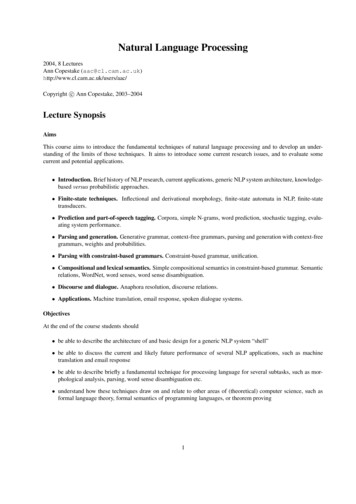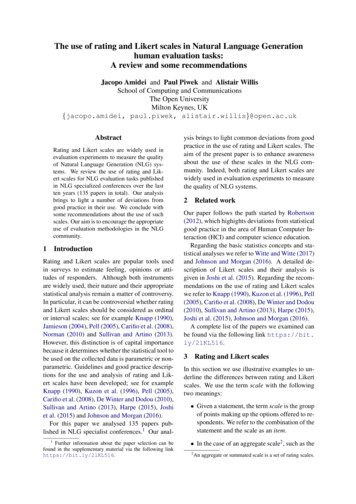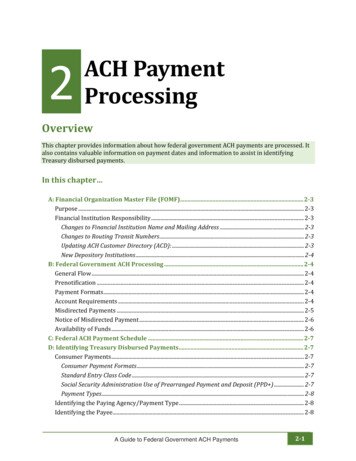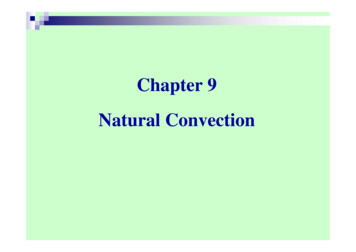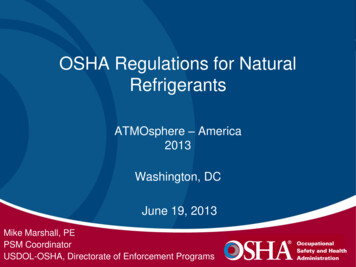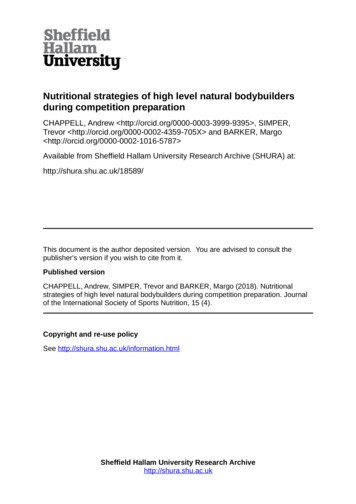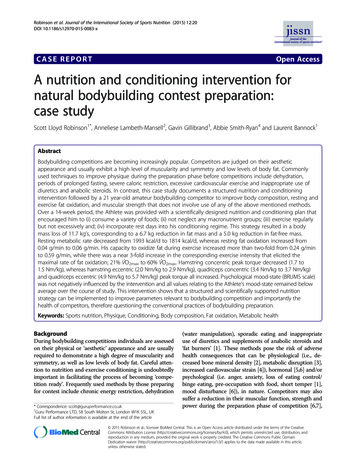
Transcription
Natural Language Processing with Python
Natural Language Processingwith PythonSteven Bird, Ewan Klein, and Edward LoperBeijing Cambridge Farnham Köln Sebastopol Taipei Tokyo
Natural Language Processing with Pythonby Steven Bird, Ewan Klein, and Edward LoperCopyright 2009 Steven Bird, Ewan Klein, and Edward Loper. All rights reserved.Printed in the United States of America.Published by O’Reilly Media, Inc., 1005 Gravenstein Highway North, Sebastopol, CA 95472.O’Reilly books may be purchased for educational, business, or sales promotional use. Online editionsare also available for most titles (http://my.safaribooksonline.com). For more information, contact ourcorporate/institutional sales department: (800) 998-9938 or corporate@oreilly.com.Editor: Julie SteeleProduction Editor: Loranah DimantCopyeditor: Genevieve d’EntremontProofreader: Loranah DimantIndexer: Ellen Troutman ZaigCover Designer: Karen MontgomeryInterior Designer: David FutatoIllustrator: Robert RomanoPrinting History:June 2009:First Edition.Nutshell Handbook, the Nutshell Handbook logo, and the O’Reilly logo are registered trademarks ofO’Reilly Media, Inc. Natural Language Processing with Python, the image of a right whale, and relatedtrade dress are trademarks of O’Reilly Media, Inc.Many of the designations used by manufacturers and sellers to distinguish their products are claimed astrademarks. Where those designations appear in this book, and O’Reilly Media, Inc. was aware of atrademark claim, the designations have been printed in caps or initial caps.While every precaution has been taken in the preparation of this book, the publisher and authors assumeno responsibility for errors or omissions, or for damages resulting from the use of the information contained herein.ISBN: 978-0-596-51649-9[M]1244726609
Table of ContentsPreface . . . . . . . . . . . . . . . . . . . . . . . . . . . . . . . . . . . . . . . . . . . . . . . . . . . . . . . . . . . . . . . . . . . . . ix1. Language Processing and Python . . . . . . . . . . . . . . . . . . . . . . . . . . . . . . . . . . . . . . . . . . 11.11.21.31.41.51.61.71.8Computing with Language: Texts and WordsA Closer Look at Python: Texts as Lists of WordsComputing with Language: Simple StatisticsBack to Python: Making Decisions and Taking ControlAutomatic Natural Language UnderstandingSummaryFurther ReadingExercises1101622273334352. Accessing Text Corpora and Lexical Resources . . . . . . . . . . . . . . . . . . . . . . . . . . . . . . . 392.12.22.32.42.52.62.72.8Accessing Text CorporaConditional Frequency DistributionsMore Python: Reusing CodeLexical ResourcesWordNetSummaryFurther ReadingExercises39525659677373743. Processing Raw Text . . . . . . . . . . . . . . . . . . . . . . . . . . . . . . . . . . . . . . . . . . . . . . . . . . . . 793.13.23.33.43.53.63.73.83.9Accessing Text from the Web and from DiskStrings: Text Processing at the Lowest LevelText Processing with UnicodeRegular Expressions for Detecting Word PatternsUseful Applications of Regular ExpressionsNormalizing TextRegular Expressions for Tokenizing TextSegmentationFormatting: From Lists to Strings80879397102107109112116v
3.10 Summary3.11 Further Reading3.12 Exercises1211221234. Writing Structured Programs . . . . . . . . . . . . . . . . . . . . . . . . . . . . . . . . . . . . . . . . . . . 1294.14.24.34.44.54.64.74.84.94.104.11Back to the BasicsSequencesQuestions of StyleFunctions: The Foundation of Structured ProgrammingDoing More with FunctionsProgram DevelopmentAlgorithm DesignA Sample of Python LibrariesSummaryFurther . Categorizing and Tagging Words . . . . . . . . . . . . . . . . . . . . . . . . . . . . . . . . . . . . . . . . 1795.15.25.35.45.55.65.75.85.95.10Using a TaggerTagged CorporaMapping Words to Properties Using Python DictionariesAutomatic TaggingN-Gram TaggingTransformation-Based TaggingHow to Determine the Category of a WordSummaryFurther ReadingExercises1791811891982022082102132142156. Learning to Classify Text . . . . . . . . . . . . . . . . . . . . . . . . . . . . . . . . . . . . . . . . . . . . . . . 2216.16.26.36.46.56.66.76.86.96.10Supervised ClassificationFurther Examples of Supervised ClassificationEvaluationDecision TreesNaive Bayes ClassifiersMaximum Entropy ClassifiersModeling Linguistic PatternsSummaryFurther ReadingExercises2212332372422452502542562562577. Extracting Information from Text . . . . . . . . . . . . . . . . . . . . . . . . . . . . . . . . . . . . . . . . 2617.1 Information Extractionvi Table of Contents261
7.27.37.47.57.67.77.87.9ChunkingDeveloping and Evaluating ChunkersRecursion in Linguistic StructureNamed Entity RecognitionRelation ExtractionSummaryFurther ReadingExercises2642702772812842852862868. Analyzing Sentence Structure . . . . . . . . . . . . . . . . . . . . . . . . . . . . . . . . . . . . . . . . . . . 2918.18.28.38.48.58.68.78.88.9Some Grammatical DilemmasWhat’s the Use of Syntax?Context-Free GrammarParsing with Context-Free GrammarDependencies and Dependency GrammarGrammar DevelopmentSummaryFurther ReadingExercises2922952983023103153213223229. Building Feature-Based Grammars . . . . . . . . . . . . . . . . . . . . . . . . . . . . . . . . . . . . . . 3279.19.29.39.49.59.6Grammatical FeaturesProcessing Feature StructuresExtending a Feature-Based GrammarSummaryFurther ReadingExercises32733734435635735810. Analyzing the Meaning of Sentences . . . . . . . . . . . . . . . . . . . . . . . . . . . . . . . . . . . . . 36110.110.210.310.410.510.610.710.8Natural Language UnderstandingPropositional LogicFirst-Order LogicThe Semantics of English SentencesDiscourse SemanticsSummaryFurther ReadingExercises36136837238539740240340411. Managing Linguistic Data . . . . . . . . . . . . . . . . . . . . . . . . . . . . . . . . . . . . . . . . . . . . . . 40711.111.211.311.4Corpus Structure: A Case StudyThe Life Cycle of a CorpusAcquiring DataWorking with XML407412416425Table of Contents vii
11.511.611.711.811.9Working with Toolbox DataDescribing Language Resources Using OLAC MetadataSummaryFurther ReadingExercises431435437437438Afterword: The Language Challenge . . . . . . . . . . . . . . . . . . . . . . . . . . . . . . . . . . . . . . . . . . . 441Bibliography . . . . . . . . . . . . . . . . . . . . . . . . . . . . . . . . . . . . . . . . . . . . . . . . . . . . . . . . . . . . . . . 449NLTK Index . . . . . . . . . . . . . . . . . . . . . . . . . . . . . . . . . . . . . . . . . . . . . . . . . . . . . . . . . . . . . . . . 459General Index . . . . . . . . . . . . . . . . . . . . . . . . . . . . . . . . . . . . . . . . . . . . . . . . . . . . . . . . . . . . . . 463viii Table of Contents
PrefaceThis is a book about Natural Language Processing. By “natural language” we mean alanguage that is used for everyday communication by humans; languages such as English, Hindi, or Portuguese. In contrast to artificial languages such as programming languages and mathematical notations, natural languages have evolved as they pass fromgeneration to generation, and are hard to pin down with explicit rules. We will takeNatural Language Processing—or NLP for short—in a wide sense to cover any kind ofcomputer manipulation of natural language. At one extreme, it could be as simple ascounting word frequencies to compare different writing styles. At the other extreme,NLP involves “understanding” complete human utterances, at least to the extent ofbeing able to give useful responses to them.Technologies based on NLP are becoming increasingly widespread. For example,phones and handheld computers support predictive text and handwriting recognition;web search engines give access to information locked up in unstructured text; machinetranslation allows us to retrieve texts written in Chinese and read them in Spanish. Byproviding more natural human-machine interfaces, and more sophisticated access tostored information, language processing has come to play a central role in the multilingual information society.This book provides a highly accessible introduction to the field of NLP. It can be usedfor individual study or as the textbook for a course on natural language processing orcomputational linguistics, or as a supplement to courses in artificial intelligence, textmining, or corpus linguistics. The book is intensely practical, containing hundreds offully worked examples and graded exercises.The book is based on the Python programming language together with an open sourcelibrary called the Natural Language Toolkit (NLTK). NLTK includes extensive software, data, and documentation, all freely downloadable from http://www.nltk.org/.Distributions are provided for Windows, Macintosh, and Unix platforms. We stronglyencourage you to download Python and NLTK, and try out the examples and exercisesalong the way.ix
AudienceNLP is important for scientific, economic, social, and cultural reasons. NLP is experiencing rapid growth as its theories and methods are deployed in a variety of new language technologies. For this reason it is important for a wide range of people to have aworking knowledge of NLP. Within industry, this includes people in human-computerinteraction, business information analysis, and web software development. Withinacademia, it includes people in areas from humanities computing and corpus linguisticsthrough to computer science and artificial intelligence. (To many people in academia,NLP is known by the name of “Computational Linguistics.”)This book is intended for a diverse range of people who want to learn how to writeprograms that analyze written language, regardless of previous programmingexperience:New to programming?The early chapters of the book are suitable for readers with no prior knowledge ofprogramming, so long as you aren’t afraid to tackle new concepts and develop newcomputing skills. The book is full of examples that you can copy and try for yourself, together with hundreds of graded exercises. If you need a more general introduction to Python, see the list of Python resources at http://docs.python.org/.New to Python?Experienced programmers can quickly learn enough Python using this book to getimmersed in natural language processing. All relevant Python features are carefullyexplained and exemplified, and you will quickly come to appreciate Python’s suitability for this application area. The language index will help you locate relevantdiscussions in the book.Already dreaming in Python?Skim the Python examples and dig into the interesting language analysis materialthat starts in Chapter 1. You’ll soon be applying your skills to this fascinatingdomain.EmphasisThis book is a practical introduction to NLP. You will learn by example, write realprograms, and grasp the value of being able to test an idea through implementation. Ifyou haven’t learned already, this book will teach you programming. Unlike otherprogramming books, we provide extensive illustrations and exercises from NLP. Theapproach we have taken is also principled, in that we cover the theoretical underpinnings and don’t shy away from careful linguistic and computational analysis. We havetried to be pragmatic in striking a balance between theory and application, identifyingthe connections and the tensions. Finally, we recognize that you won’t get through thisunless it is also pleasurable, so we have tried to include many applications and examples that are interesting and entertaining, and sometimes whimsical.x Preface
Note that this book is not a reference work. Its coverage of Python and NLP is selective,and presented in a tutorial style. For reference material, please consult the substantialquantity of searchable resources available at http://python.org/ and http://www.nltk.org/.This book is not an advanced computer science text. The content ranges from introductory to intermediate, and is directed at readers who want to learn how to analyzetext using Python and the Natural Language Toolkit. To learn about advanced algorithms implemented in NLTK, you can examine the Python code linked from http://www.nltk.org/, and consult the other materials cited in this book.What You Will LearnBy digging into the material presented here, you will learn: How simple programs can help you manipulate and analyze language data, andhow to write these programs How key concepts from NLP and linguistics are used to describe and analyzelanguage How data structures and algorithms are used in NLP How language data is stored in standard formats, and how data can be used toevaluate the performance of NLP techniquesDepending on your background, and your motivation for being interested in NLP, youwill gain different kinds of skills and knowledge from this book, as set out in Table P-1.Table P-1. Skills and knowledge to be gained from reading this book, depending on readers’ goals andbackgroundGoalsBackground in arts and humanitiesBackground in science and engineeringLanguageanalysisManipulating large corpora, exploring linguisticmodels, and testing empirical claims.Using techniques in data modeling, data mining, andknowledge discovery to analyze natural language.LanguagetechnologyBuilding robust systems to perform linguistic taskswith technological applications.Using linguistic algorithms and data structures in robustlanguage processing software.OrganizationThe early chapters are organized in order of conceptual difficulty, starting with a practical introduction to language processing that shows how to explore interesting bodiesof text using tiny Python programs (Chapters 1–3). This is followed by a chapter onstructured programming (Chapter 4) that consolidates the programming topics scattered across the preceding chapters. After this, the pace picks up, and we move on toa series of chapters covering fundamental topics in language processing: tagging, classification, and information extraction (Chapters 5–7). The next three chapters look atPreface xi
ways to parse a sentence, recognize its syntactic structure, and construct representations of meaning (Chapters 8–10). The final chapter is devoted to linguistic data andhow it can be managed effectively (Chapter 11). The book concludes with an Afterword, briefly discussing the past and future of the field.Within each chapter, we switch between different styles of presentation. In one style,natural language is the driver. We analyze language, explore linguistic concepts, anduse programming examples to support the discussion. We often employ Python constructs that have not been introduced systematically, so you can see their purpose beforedelving into the details of how and why they work. This is just like learning idiomaticexpressions in a foreign language: you’re able to buy a nice pastry without first havinglearned the intricacies of question formation. In the other style of presentation, theprogramming language will be the driver. We’ll analyze programs, explore algorithms,and the linguistic examples will play a supporting role.Each chapter ends with a series of graded exercises, which are useful for consolidatingthe material. The exercises are graded according to the following scheme: is for easyexercises that involve minor modifications to supplied code samples or other simpleactivities; is for intermediate exercises that explore an aspect of the material in moredepth, requiring careful analysis and design; is for difficult, open-ended tasks thatwill challenge your understanding of the material and force you to think independently(readers new to programming should skip these).Each chapter has a further reading section and an online “extras” section at http://www.nltk.org/, with pointers to more advanced materials and online resources. Online versions of all the code examples are also available there.Why Python?Python is a simple yet powerful programming language with excellent functionality forprocessing linguistic data. Python can be downloaded for free from http://www.python.org/. Installers are available for all platforms.Here is a five-line Python program that processes file.txt and prints all the words endingin ing: for line in open("file.txt"):.for word in line.split():.if word.endswith('ing'):.print wordThis program illustrates some of the main features of Python. First, whitespace is usedto nest lines of code; thus the line starting with if falls inside the scope of the previousline starting with for; this ensures that the ing test is performed for each word. Second,Python is object-oriented; each variable is an entity that has certain defined attributesand methods. For example, the value of the variable line is more than a sequence ofcharacters. It is a string object that has a “method” (or operation) called split() thatxii Preface
we can use to break a line into its words. To apply a method to an object, we write theobject name, followed by a period, followed by the method name, i.e., line.split().Third, methods have arguments expressed inside parentheses. For instance, in the example, word.endswith('ing') had the argument 'ing' to indicate that we wanted wordsending with ing and not something else. Finally—and most importantly—Python ishighly readable, so much so that it is fairly easy to guess what this program does evenif you have never written a program before.We chose Python because it has a shallow learning curve, its syntax and semantics aretransparent, and it has good string-handling functionality. As an interpreted language,Python facilitates interactive exploration. As an object-oriented language, Python permits data and methods to be encapsulated and re-used easily. As a dynamic language,Python permits attributes to be added to objects on the fly, and permits variables to betyped dynamically, facilitating rapid development. Python comes with an extensivestandard library, including components for graphical programming, numerical processing, and web connectivity.Python is heavily used in industry, scientific research, and education around the world.Python is often praised for the way it facilitates productivity, quality, and maintainability of software. A collection of Python success stories is posted at http://www.python.org/about/success/.NLTK defines an infrastructure that can be used to build NLP programs in Python. Itprovides basic classes for representing data relevant to natural language processing;standard interfaces for performing tasks such as part-of-speech tagging, syntactic parsing, and text classification; and standard implementations for each task that can becombined to solve complex problems.NLTK comes with extensive documentation. In addition to this book, the website athttp://www.nltk.org/ provides API documentation that covers every module, class, andfunction in the toolkit, specifying parameters and giving examples of usage. The websitealso provides many HOWTOs with extensive examples and test cases, intended forusers, developers, and instructors.Software RequirementsTo get the most out of this book, you should install several free software packages.Current download pointers and instructions are available at http://www.nltk.org/.PythonThe material presented in this book assumes that you are using Python version 2.4or 2.5. We are committed to porting NLTK to Python 3.0 once the libraries thatNLTK depends on have been ported.NLTKThe code examples in this book use NLTK version 2.0. Subsequent releases ofNLTK will be backward-compatible.Preface xiii
NLTK-DataThis contains the linguistic corpora that are analyzed and processed in the book.NumPy (recommended)This is a scientific computing library with support for multidimensional arrays andlinear algebra, required for certain probability, tagging, clustering, and classification tasks.Matplotlib (recommended)This is a 2D plotting library for data visualization, and is used in some of the book’scode samples that produce line graphs and bar charts.NetworkX (optional)This is a library for storing and manipulating network structures consisting ofnodes and edges. For visualizing semantic networks, also install the Graphvizlibrary.Prover9 (optional)This is an automated theorem prover for first-order and equational logic, used tosupport inference in language processing.Natural Language Toolkit (NLTK)NLTK was originally created in 2001 as part of a computational linguistics course inthe Department of Computer and Information Science at the University of Pennsylvania. Since then it has been developed and expanded with the help of dozens of contributors. It has now been adopted in courses in dozens of universities, and serves asthe basis of many research projects. Table P-2 lists the most important NLTK modules.Table P-2. Language processing tasks and corresponding NLTK modules with examples offunctionalityLanguage processing taskNLTK modulesFunctionalityAccessing corporanltk.corpusStandardized interfaces to corpora and lexiconsString processingnltk.tokenize, nltk.stemTokenizers, sentence tokenizers, stemmersCollocation discoverynltk.collocationst-test, chi-squared, point-wise mutual informationPart-of-speech taggingnltk.tagn-gram, backoff, Brill, HMM, TnTClassificationnltk.classify, nltk.clusterDecision tree, maximum entropy, naive Bayes, EM, k-meansChunkingnltk.chunkRegular expression, n-gram, named entityParsingnltk.parseChart, feature-based, unification, probabilistic, dependencySemantic interpretationnltk.sem, nltk.inferenceLambda calculus, first-order logic, model checkingEvaluation metricsnltk.metricsPrecision, recall, agreement coefficientsProbability and estimationnltk.probabilityFrequency distributions, smoothed probability distributionsApplicationsnltk.app, nltk.chatGraphical concordancer, parsers, WordNet browser, chatbotsxiv Preface
Language processing taskNLTK modulesFunctionalityLinguistic fieldworknltk.toolboxManipulate data in SIL Toolbox formatNLTK was designed with four primary goals in mind:SimplicityTo provide an intuitive framework along with substantial building blocks, givingusers a practical knowledge of NLP without getting bogged down in the tedioushouse-keeping usually associated with processing annotated language dataConsistencyTo provide a uniform framework with consistent interfaces and data structures,and easily guessable method namesExtensibilityTo provide a structure into which new software modules can be easily accommodated, including alternative implementations and competing approaches to thesame taskModularityTo provide components that can be used independently without needing to understand the rest of the toolkitContrasting with these goals are three non-requirements—potentially useful qualitiesthat we have deliberately avoided. First, while the toolkit provides a wide range offunctions, it is not encyclopedic; it is a toolkit, not a system, and it will continue toevolve with the field of NLP. Second, while the toolkit is efficient enough to supportmeaningful tasks, it is not highly optimized for runtime performance; such optimizations often involve more complex algorithms, or implementations in lower-level programming languages such as C or C . This would make the software less readableand more difficult to install. Third, we have tried to avoid clever programming tricks,since we believe that clear implementations are preferable to ingenious yet indecipherable ones.For InstructorsNatural Language Processing is often taught within the confines of a single-semestercourse at the advanced undergraduate level or postgraduate level. Many instructorshave found that it is difficult to cover both the theoretical and practical sides of thesubject in such a short span of time. Some courses focus on theory to the exclusion ofpractical exercises, and deprive students of the challenge and excitement of writingprograms to automatically process language. Other courses are simply designed toteach programming for linguists, and do not manage to cover any significant NLP content. NLTK was originally developed to address this problem, making it feasible tocover a substantial amount of theory and practice within a single-semester course, evenif students have no prior programming experience.Preface xv
A significant fraction of any NLP syllabus deals with algorithms and data structures.On their own these can be rather dry, but NLTK brings them to life with the help ofinteractive graphical user interfaces that make it possible to view algorithms step-bystep. Most NLTK components include a demonstration that performs an interestingtask without requiring any special input from the user. An effective way to deliver thematerials is through interactive presentation of the examples in this book, enteringthem in a Python session, observing what they do, and modifying them to explore someempirical or theoretical issue.This book contains hundreds of exercises that can be used as the basis for studentassignments. The simplest exercises involve modifying a supplied program fragment ina specified way in order to answer a concrete question. At the other end of the spectrum,NLTK provides a flexible framework for graduate-level research projects, with standardimplementations of all the basic data structures and algorithms, interfaces to dozensof widely used datasets (corpora), and a flexible and extensible architecture. Additionalsupport for teaching using NLTK is available on the NLTK website.We believe this book is unique in providing a comprehensive framework for studentsto learn about NLP in the context of learning to program. What sets these materialsapart is the tight coupling of the chapters and exercises with NLTK, giving students—even those with no prior programming experience—a practical introduction to NLP.After completing these materials, students will be ready to attempt one of the moreadvanced textbooks, such as Speech and Language Processing, by Jurafsky and Martin(Prentice Hall, 2008).This book presents programming concepts in an unusual order, beginning with a nontrivial data type—lists of strings—then introducing non-trivial control structures suchas comprehensions and conditionals. These idioms permit us to do useful languageprocessing from the start. Once this motivation is in place, we return to a systematicpresentation of fundamental concepts such as strings, loops, files, and so forth. In thisway, we cover the same ground as more conventional approaches, without expectingreaders to be interested in the programming language for its own sake.Two possible course plans are illustrated in Table P-3. The first one presumes an arts/humanities audience, whereas the second one presumes a science/engineering audience. Other course plans could cover the first five chapters, then devote the remainingtime to a single area, such as text classification (Chapters 6 and 7), syntax (Chapters8 and 9), semantics (Chapter 10), or linguistic data management (Chapter 11).Table P-3. Suggested course plans; approximate number of lectures per chapterChapterArts and HumanitiesScience and EngineeringChapter 1, Language Processing and Python2–42Chapter 2, Accessing Text Corpora and Lexical Resources2–42Chapter 3, Processing Raw Text2–42Chapter 4, Writing Structured Programs2–41–2xvi Preface
ChapterArts and HumanitiesScience and EngineeringChapter 5, Categorizing and Tagging Words2–42–4Chapter 6, Learning to Classify Text0–22–4Chapter 7, Extracting Information from Text22–4Chapter 8, Analyzing Sentence Structure2–42–4Chapter 9, Building Feature-Based Grammars2–41–4Chapter 10, Analyzing the Meaning of Sentences1–21–4Chapter 11, Managing Linguistic Data1–21–4Total18–3618–36Conventions Used in This BookThe following typographical conventions are used in this book:BoldIndicates new terms.ItalicUsed within paragraphs to refer to linguistic examples, the names of texts, andURLs; also used for filenames and file extensions.Constant widthUsed for program listings, as well as within paragraphs to refer to program elementssuch as variable or function names, statements, and keywords; also used for program names.Constant width italicShows text that should be replaced with user-supplied values or by values determined by context; also used for metavariables within program code examples.This icon signifies a tip, suggestion, or general note.This icon indicates a warning or caution.Using Code ExamplesThis book is here to help you get your job done. In general, you may use the code inthis book in your programs and documentation. You do not need to contact us forpermission unless you’re reproducing a significant portion of the code. For example,Preface xvii
writing a program that uses several chunks of code from this book does not requirepermission. Selling or distributing a CD-ROM of examples from O’Reilly books doesrequire permission. Answering a question by citing this book and quoting examplecode does not require permission. Incorporating a significant amount of example codefrom this book into your product’s documentation does require permission.We appreciate, but do not require, attribution. An attribution usually includes the title,author, publisher, and ISBN. For example: “Natural Language Processing with Python, by Steven Bird, Ewan Klein, and Edward Loper. Copyright 2009 Steven Bird,Ewan Klein, and Edward Loper, 978-0-596-51649-9.”If you feel your use of code examples falls outside fair use or the permission given above,feel free to contact us at permissions@oreilly.com.Safari Books OnlineWhen you see a Safari Books Online icon on the cover of your favoritetechnology book, that means the book is available online through theO’Reilly Network Safari Bookshelf.Safari offers a solution that’s better than e-books. It’s a virtual library that lets you easilysearch thousands of top tech books, cut and paste code samples, download chapters,and find quick answers when you need the most accurate, current information. Try itfor free at http://my.safaribooksonline.com.How to Contact UsPlease address comm
Already dreaming in Python? Skim the Python examples and dig into the interesting language analysis material that starts in Chapter 1. You’ll soon be applying your skills to this fascinating domain. Emphasis This book i

